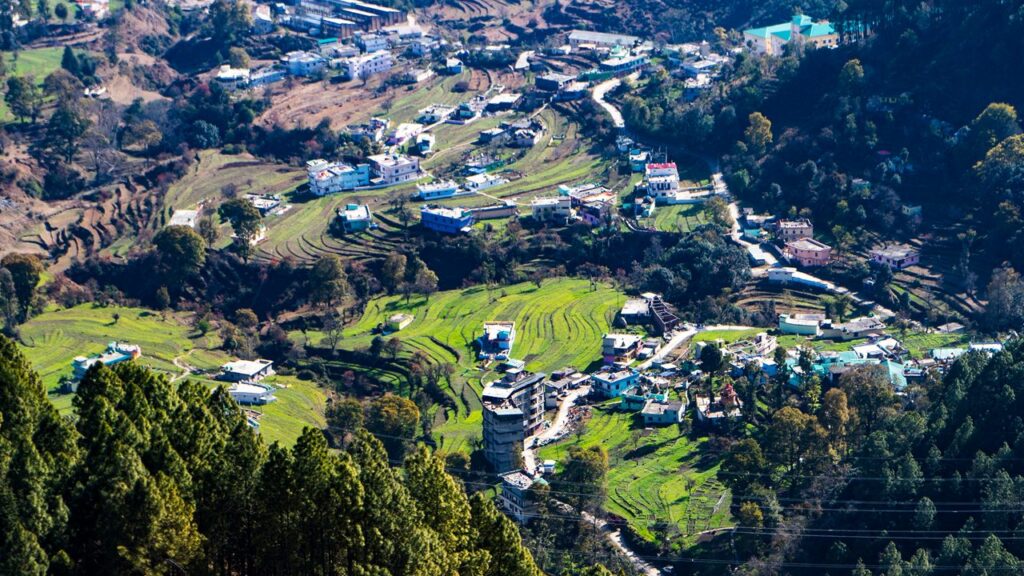
Geography and Natural Beauty
Sarmoli sits at an altitude of around 7,000 feet above sea level and offers breathtaking views of the snow-clad Panchachuli range, the Himalayan forests, alpine meadows, and traditional Kumaoni architecture. The village is surrounded by deodar, oak, and rhododendron forests, making it a paradise for bird watchers, photographers, and hikers.
- Nearby attractions include:
- Munsiyari town (4 km away)
- Khalia Top trek
- Thamri Kund (a sacred high-altitude lake)
- Milam and Ralam Glaciers
🌱 A Model for Responsible Tourism
What makes Sarmoli truly unique is its approach to community-based ecotourism. Unlike commercial tourist destinations, Sarmoli limits the number of visitors each year and promotes homestays run by local women. Guests are encouraged to live like locals, eat home-cooked food, and participate in daily village life — from farming to weaving.
Initiated in the early 2000s by Malika Virdi, a mountaineer and social activist, the village’s tourism model ensures that:
- Revenue stays within the local economy
- Culture and nature are preserved
- Locals are trained in hospitality, guiding, and waste management
🐦 A Birdwatcher’s Haven
Sarmoli is often described as a “birder’s dream.” Over 200 species of birds are found in the region, including:
- Himalayan Monal (the state bird of Uttarakhand)
- White-throated Laughingthrush
- Rufous-bellied Woodpecker
Each year in May, the village hosts a Bird Festival, which includes nature walks, bird counts, photography contests, and workshops — all conducted with zero ecological impact.
👩🌾 Empowering Women and Local Communities
The heart of Sarmoli’s transformation lies in women’s empowerment. Local women run homestays, take up guiding and trekking roles, manage finances, and participate in decision-making bodies. The Maati Sangathan, a local women’s collective, plays a crucial role in managing resources, promoting organic farming, and safeguarding traditional knowledge.
This self-reliance model is a shining example of how tourism can uplift, not exploit.
🥾 Adventure and Treks Around Sarmoli
For trekking enthusiasts, Sarmoli is a gateway to some of the most beautiful Himalayan trails:
- Khalia Top Trek: A relatively easy trek with stunning sunrise views.
- Thamri Kund: A short hike to a sacred pond amidst rhododendron forests.
- Milam Glacier Trek: A more intense multi-day trek for serious adventurers.
- Darkot and Martoli villages: Routes rich in historical trade stories and ancient architecture.
🌿 Sustainability Practices
Sarmoli sets a benchmark for low-carbon travel. The villagers practice:
- Rainwater harvesting
- Zero-waste living
- Solar cooking and lighting
- Organic farming
Plastic is discouraged, and tourists are expected to respect local customs, carry back their waste, and support ethical travel.
🎨 Cultural Immersion
From listening to Kumaoni folk songs by the fire, learning traditional weaving, eating Bichoo Buti saag (a local nettle dish), or simply helping in terrace farming — staying in Sarmoli is more than a holiday; it’s a cultural exchange. Visitors often leave with deep friendships, stories, and a renewed sense of purpose.
📌 Why Visit Sarmoli?
If you’re tired of overtourism, overpricing, and underwhelming experiences in typical hill stations, Sarmoli is your answer. It’s ideal for:
- Nature lovers
- Solo travelers
- Eco-tourists
- Writers, artists, and photographers seeking inspiration
- Anyone wanting to detox from city life
🧭 How to Reach Sarmoli
- By Road: Nearest town is Munsiyari. From Delhi, it’s around 600 km via Almora or Bageshwar.
- By Train: Nearest station is Kathgodam. From there, take a shared taxi or bus.
- By Air: The closest airport is Pantnagar Airport, approximately 290 km away.
🛖 Where to Stay?
Forget luxury hotels. Choose from:
- Local homestays
- Eco-huts
- Forest rest houses
Make sure to book in advance, as the number of tourists is limited each season to protect the environment.
🔚 Final Thoughts
Sarmoli isn’t just a place on the map — it’s a movement. A reminder that tourism can be respectful, regenerative, and deeply enriching. By visiting Sarmoli, you’re not just witnessing the Himalayas, you’re helping preserve them.
